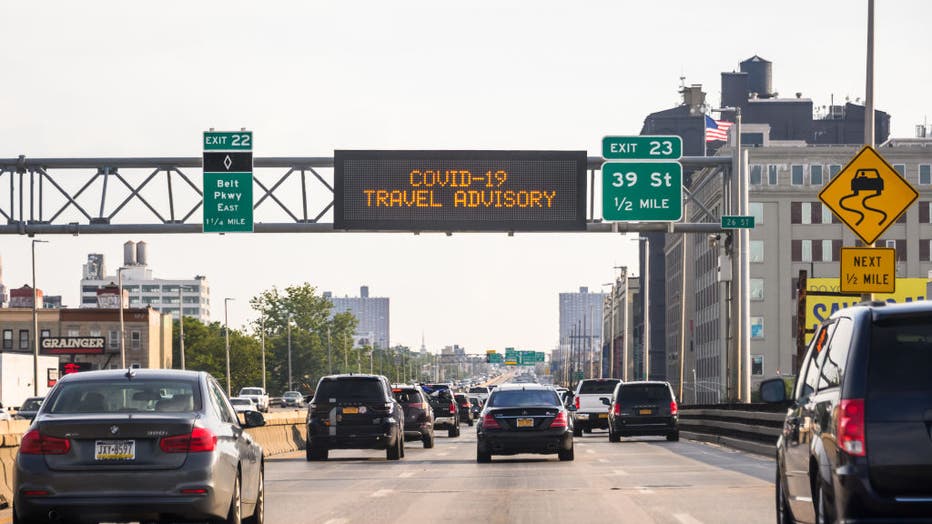COVID-19 travel advisory list for NJ, CT; NY qurantine requirements
NEW YORK - In an effort to curb the spread of the coronavirus, all travelers to New Jersey, and Connecticut from states with a significant spread of COVID-19 are required to quarantine for 14 days upon entering the tristate area.
On Oct. 31, New York Gov. Andrew Cuomo announced that New York was ditching its quarantine list and would require travelers from all non-neighboring states to test negative for COVID-19 no more than three days before entering New York.
Individuals arriving without proof of a negative test wouldn't be stopped from entering the state, but would be required to quarantine for 14 days. Individuals who test negative would still have to quarantine for three days after arrival then take a second test. If that’s negative, they can stop quarantining.
RELATED: Cuomo: Travelers to NY must test for virus, nearby states exempted
Travelers who decide not to get tested will be required to quarantine for 14 days, the governor said.
As of Tuesday, October 27, 41 states and jurisdictions are on the travel advisory list after California was added.
On June 24, the governors of each state held a joint news conference announcing the travel advisory. Since then the list has continued to grow. Indeed, New Jersey and Connecticut's own virus rates have risen high enough to land them on the list.
But Gov. Andrew Cuomo said New York won't be able to enforce the quarantine for travelers from its neighboring states because of their closely linked economies and geography.
"There are just too many interchanges. There are too many interconnections. There are too many people who live in one place and work in the other," Cuomo said on Oct. 20. "It would have a disastrous effect on the economy and remember what we're fighting this public health pandemic, we're also fighting to open up the economy."
The restriction requires travelers and those residents who are returning from impacted states to self-quarantine at their home, or a hotel or other temporary lodging. Individuals should leave the place of self-quarantine only to seek medical care and treatment or to obtain food and other essential items.
The formula to determine which travelers should quarantine is based on those coming from states where there is a positive test rate higher than 10 per 100,000 residents over a 7-day rolling average or a state with a 10% or higher positivity rate over a 7-day rolling average.
JOINT STATEMENT FROM NEW YORK GOV. ANDREW CUOMO, NEW JERSEY GOV. PHIL MURPHY AND CONNECTICUT GOV. NED LAMONT
"Our states have worked together successfully in combating this pandemic since the beginning and we'll continue to do so. The travel advisory was designed to keep our respective states safe, with the understanding that we are a connected region, dependent on each other when it comes to commerce, education, and health care. We're urging all of our residents to avoid unnecessary or non-essential travel between states at this time, but will not subject residents of our states to a quarantine if coming from a neighboring state. New York, New Jersey, and Connecticut have among the lowest infection rates in the country because we have based our approaches to controlling the spread on science and data, and we will continue to do so."
The number of states and locations added to the travel advisory has fluctuated from week to week. Here is the list, as of Oct. 27, 2020:
- Alaska
- Alabama
- Arkansas
- Arizona
- California
- Colorado
- Delaware
- Florida
- Georgia
- Guam
- Iowa
- Idaho
- Illinois
- Indiana
- Kansas
- Kentucky
- Louisiana
- Maryland
- Michigan
- Minnesota
- Missouri
- Mississippi
- Montana
- North Carolina
- North Dakota
- Nebraska
- New Mexico
- Nevada
- Ohio
- Oklahoma
- Puerto Rico
- Rhode Island
- South Carolina
- South Dakota
- Tennessee
- Texas
- Utah
- Virginia
- Wisconsin
- West Virginia
- Wyoming

NEW YORK, NEW YORK - JULY 05: A sign displaying COVID-19 travel advisory above a road in Brooklyn as New York City(Photo by Noam Galai/Getty Images)
In New York, anyone arriving at airports from states and territories on the list must complete a form with health details. Travelers who leave the airport without completing the form will be subject to a $2,000 fine and may be brought to a hearing and ordered to complete mandatory quarantine. Travelers arriving in New York through other means of transport, including trains and cars, must fill out the form online at this LINK.
In New Jersey, the self-quarantine is voluntary, but compliance is expected. Anyone who meets the standard for quarantining is asked to fill out an online survey with travel information. The data will be shared with local New Jersey Public Health authorities and other third parties when required by law. Local health departments will contact you to remind you to self-quarantine and offer assistance including information about testing locations.
Access the survey by visiting covid19.nj.gov/njtravel or texting "NJTRAVEL" to 898211.
In Connecticut, travelers are required to complete the Connecticut Travel Health Form available at this LINK.

